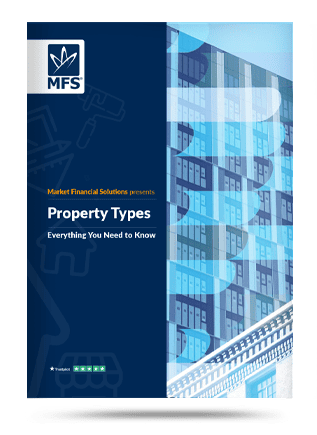Market Financial Solutions are a bridging loan and buy-to-let mortgage provider and are not legal, financial, investment or tax advisers. This document is for informational purposes only and does not, and should not be considered, to constitute legal, financial, investment or tax advice or be relied upon by any person to make a legal, financial, investment or tax decision. Therefore, Investors are encouraged to seek appropriate professional advice. The information in this content is correct at time of writing.

Much is written about supply and demand within the UK property market. But it can be tricky to visualise just how many homes are in the UK. Let alone understand how many more we need.
For residential property alone, there are multiple options available to property investors. And this is before one factors in countless sub-categories and market dynamics.
To help break down the options, this blog will explore how many dwellings in the UK there are. We’ll highlight where supply is lacking, and where investment could be sorely needed.
Residential property – how many homes in the UK could be utilised?
The latest data from the ONS[1] revealed there were an estimated 28.4 million households in the UK in 2023. This was up 6% when compared with 2013.
Separate data from the Ministry of Housing Communities & Local Government[2] showed there were an estimated 24.7 million households in England living in self-contained accommodation in 2023/24. It also showed that owner occupation remained the largest tenure group, with 16 million households, representing 65% of all households in England in 2023-24.
Meanwhile, the private rented sector accounted for 4.7 million or 19% of households, and the social rented sector had 4 million households (16%).
There were 19.3 million families spread across the UK in 2023[3], and married or civil-partnered couple families accounted for the majority (66%) of these families. Cohabiting couple families accounted for 18%, and lone-parent families accounted for the remaining 16%.
According to analysis from IBIS World[4], the total number of households in the UK could reach 28.7 million by the end of 2025. Whether we substantially increase our stock levels this year is up for debate but the National House Building Council (NHBC[5]) did recently share that nearly 30,000 new homes were registered to be built in Q1, up 36% year-on-year.
What types of property are people living in?
Property investors need to not only better understand how many homes are in the UK, but what types are becoming more necessary. Across England and Wales, most households (77.9%) live in houses or bungalows, according to the 2021 census[6].
Some 21.7% live in a flat, maisonette or apartment, while 0.4% live in a caravan or other mobile or temporary structure. When looking over the last 10 years, it’s clear to see how economic pressures have forced adaptation.
In 2021, 62.5% of the population owned their accommodation. Down from 64.3% in 2011. Also, the proportion of households living in a flat, maisonette or apartment increased the most over the decade. Rising from 4.9 million in 2011, to 5.4 million in 2021. This could be the result of rising costs limiting people’s ability to live in larger homes.

We need more supply to meet demand
When it comes to housing though, what will be on most people’s minds is the general lack of it. It’s believed 300,000 homes need to be built every year to keep up with demand. We’ve rarely come close to that figure.
The wider population may be more likely to ask themselves why aren’t more homes available, rather than how many homes we have in the UK. In fact, between 2011 and 2021, the population grew faster, or at the same pace, as the number of homes in 150 out of 309 local authorities[7].
Regardless of where new houses could come from, we need to build and provide more suitable options to have a healthy supply over the coming years. The latest official projections suggest our population could pass the 70 million mark by mid-2026[8]. Where will these people live?
Should we look to the commercial market for a solution?
Demand for commercial property has been hit in recent years. Likely because of the pandemic, changing working practices, and wider economic challenges. Commercial property deals plummeted following the lockdown years, and the mini-budget.
There were £7bn worth of deals transacted in the final quarter of 2022[9], the lowest quarterly total since at least 2010. Also, nearly 50 UK shops closed for good every day in 2022[10].
Fortunately, there has been a bit of a rebound in the commercial property space in more recent months. Student accommodation, office space, and retail developments are fuelling a UK commercial property rebound according to recent analysis[11]. Chances are, many of these kinds of assets are being bought for their conversion potential. Commercial-to-residential permitted development applications have a hit a record high[12], as it appears that many investors and developers are recognising that we may have a much clearer need for residential property over commercial assets.
Looking ahead
The overall number of homes in the UK has rarely been: enough. But, major efforts are under way to reverse this. The current government is pouring its resources into building 1.5 million homes over the next few years[13]. While it remains to be seen if the state is capable of delivering this, it has expressed a keen willingness to work with the private sector to get building[14].
Moreover, Labour is keen to build brand new towns across the UK, and over 100 potential, undisclosed sites have been put forward by councils, developers, and landowners to the taskforce.
Then there is the Renters’ Rights Bill, and new looming rules that may force commercial property owners into auctions[15]. These may force some existing property owners to sell-up, which could add stock to the market.
Regardless of what’s on the horizon, we will be at the ready to help property investors play their part in delivering more houses to the UK.
[1] https://www.ons.gov.uk/peoplepopulationandcommunity/birthsdeathsandmarriages/families/bulletins/familiesandhouseholds/2023
[2] https://www.gov.uk/government/statistics/chapters-for-english-housing-survey-2023-to-2024-headline-findings-on-demographics-and-household-resilience/chapter-1-profile-of-households-and-dwellings#:~:text=In%202023%2C%20there%20were%20an,were%20social%20rented%20(16%25).
[3] https://www.ons.gov.uk/peoplepopulationandcommunity/birthsdeathsandmarriages/families/bulletins/familiesandhouseholds/2023#families
[4] https://www.ibisworld.com/uk/bed/number-of-households/44090/
[5] https://www.nhbc.co.uk/insights-and-media/insights/new-home-registrations-rise-in-q1-with-developers-encouraged-by-government-focus-on-housing-reports-nhbc
[6] https://www.ons.gov.uk/peoplepopulationandcommunity/housing/bulletins/housingenglandandwales/census2021#how-housing-varied-across-england-and-wales
[7] https://www.mortgagesolutions.co.uk/better-business/2023/01/09/the-case-of-new-builds-as-uk-housing-supply-continues-to-dwindle-hall/
[8] https://www.ons.gov.uk/peoplepopulationandcommunity/populationandmigration/populationprojections/bulletins/nationalpopulationprojections/2022based
[9] https://www.ft.com/content/a0976966-1e64-427d-b165-36e4da21433d
[10] https://www.theguardian.com/business/2023/jan/02/almost-50-uk-shops-closed-for-good-every-day-in-2022-says-report
[11] https://bridgingandcommercial.co.uk/article/21333/student-accommodation-office-space-and-retail-development-fuel-uk-commercial-property-rebound
[12] https://www.planningresource.co.uk/article/1916387/why-commercial-to-residential-permitted-development-applications-hit-record-high
[13] https://www.bbc.co.uk/news/articles/c9d528g755qo
[14] https://www.gov.uk/government/news/long-term-public-private-partnership-to-deliver-thousands-of-affordable-homes#:~:text=PIC%20has%20invested%20around%20%C2%A3,force%20in%20delivering%20affordable%20housing.
[15] https://www.gov.uk/government/publications/high-street-rental-auctions-non-statutory-guidance/high-street-rental-auctions-non-statutory-guidance

The Complete Guide to
Property Types
Everything you need to know
- Residential property types
- Commercial property types
- Property types by ownership
- Property types by investment goal
- Regional variations & more





